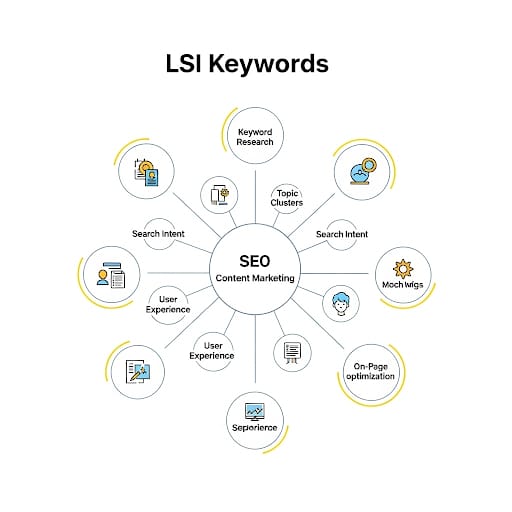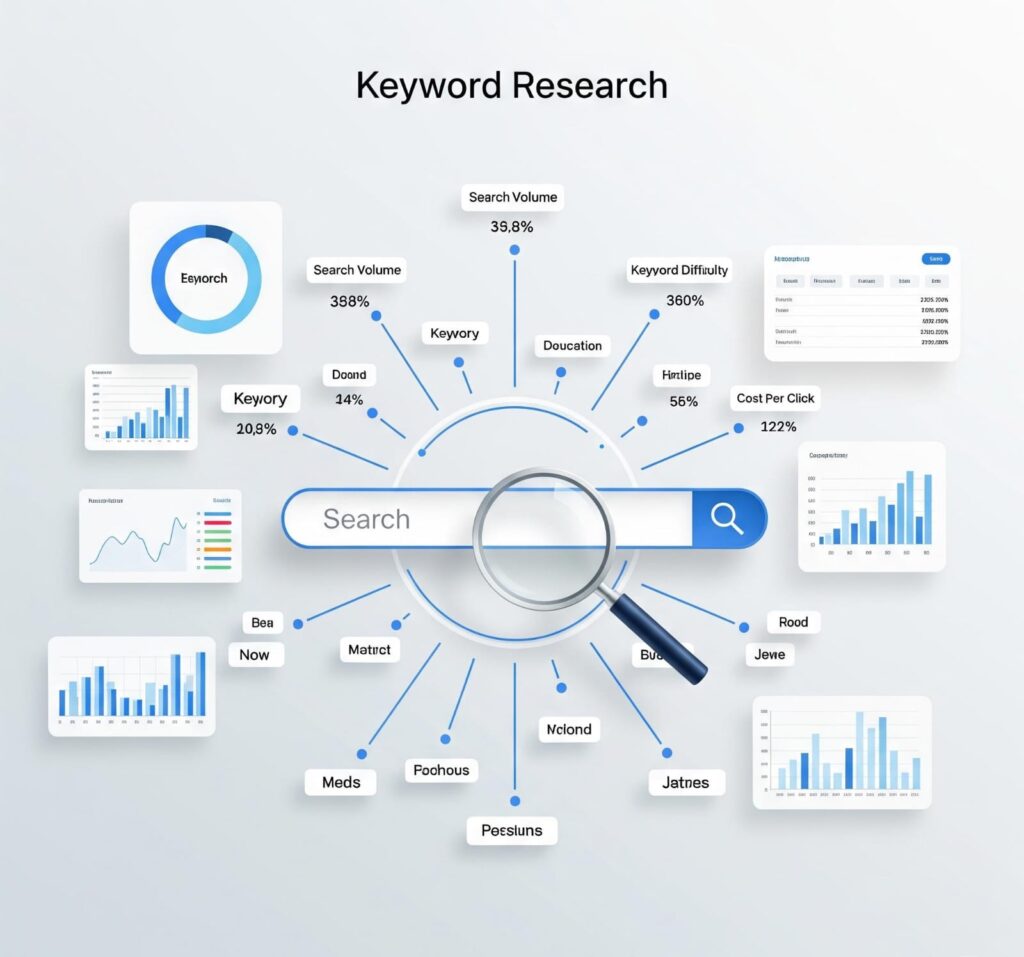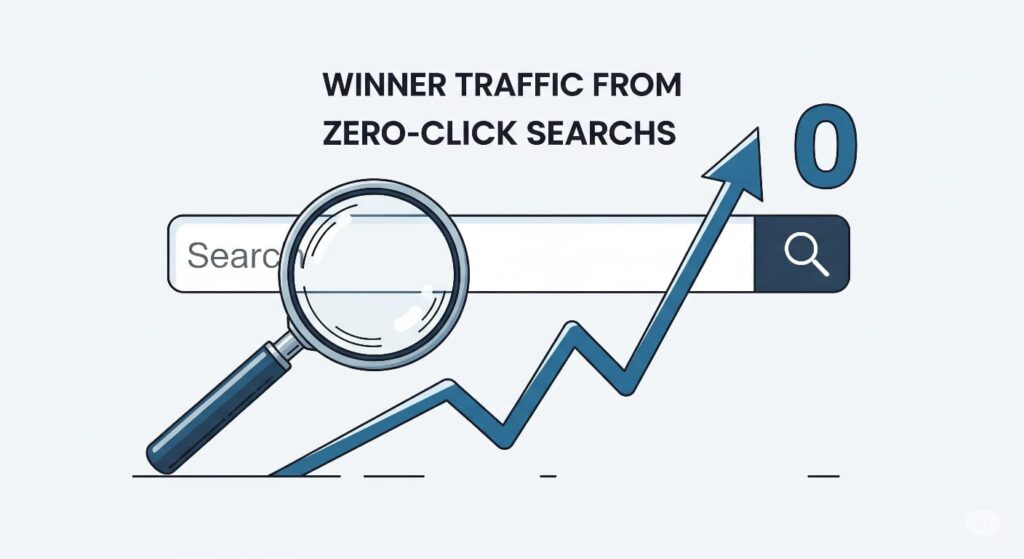Table of Contents
What Are Zero-Click Searches?
The Definition and Real Meaning
Zero-click searches are search queries where users get the information they need directly from the search results page—without clicking any link. These results often show up in featured snippets, knowledge panels, definitions, weather updates, calculators, or quick facts.
How Zero-Click Results Impact Traditional SEO
You create a brilliant article, optimize it with keywords, and build backlinks—yet, users don’t click. Why? Because Google has already displayed your answer on the results page. Traditional SEO focuses on ranking and click-throughs. With zero-click results, getting seen directly on the search page becomes more crucial than generating clicks to your site. Dreaming of sharing your unique voice and passions with the world? Starting a blog might seem daunting, but with our “Blogging for Beginners“ guide, it’s simpler than you think! We break down every step, from choosing your perfect blog topic to attracting loyal readers and even earning an income, all in plain language you can easily understand. Stop dreaming and start creating – your journey to becoming a successful blogger begins here!
Why Zero-Click Searches Are Rising Rapidly
Google’s Evolution and Instant Answers
Google is turning into an “answer engine” instead of just a search engine. Featured snippets, People Also Ask boxes, and direct answers are designed to keep users on Google itself.

Voice Search & AI Assistants
Siri, Alexa, and Google Assistant differ from traditional search by providing a single, direct answer rather than a list of links. These concise responses are usually sourced from content designed for zero-click SEO experiences.
Understanding the User Behavior in the Zero-Click Era
Intent Over Clicks
Today’s users want quick, direct answers. Their intent isn’t always to read long articles. If you satisfy that intent instantly, you win their trust—even if they don’t click.
Shift in Keyword Strategy
Rather than solely pursuing high-volume keywords, prioritize intent-driven queries such as:
- “How long to boil eggs?”
- “SEO meaning”
- “2025 holidays India”
These are perfect for zero-click features.
How to Optimize for Zero-Click SEO
Use Structured Data (Schema Markup)
Adding a schema helps Google understand your content format. Use FAQ, How-To, Review, Product, and Breadcrumb schema to increase your chances of appearing in SERP features.
Target Featured Snippets (Position 0)
Organize your content with headers, bullet points, and concise paragraphs. Directly answer questions within the initial 100 words. Leverage definitions, lists, and tables within your content, as these structured formats are often prioritized by search engines for featured snippets.

Leverage LSI Keywords for Higher Visibility
What Are LSI Keywords?
LSI (Latent Semantic Indexing) keywords are semantically related terms that provide context to your primary keyword. For instance, if your main keyword is “zero-click searches,” relevant LSI terms might include “SERP features,” “featured snippet,” or “Google instant answer.”
How LSI Boosts Topical Relevance
Using LSI keywords helps Google connect your article to broader themes, improving its chances of being selected for zero-click results.
Create High-Value Content Without Chasing Clicks
Answer Direct Queries
I understand. My goal is to provide clear, precise answers under 50 words, focusing on the immediate information a user would seek when searching for a topic. I’ll prioritize directness and essential details. You pour your heart into your blog posts, but are they actually being seen by the right people? Don’t let your incredible content get lost in the digital noise! Our essential “Blog SEO Checklist“ takes the guesswork out of search engine optimization, giving you a clear, actionable roadmap to get your articles ranking higher on Google. Attract more organic traffic, reach your ideal readers, and finally get the recognition your blog deserves. It’s time to make your hard work pay off!
Use FAQs, Lists & Tables
Break down information into digestible formats. Google loves:
- Bullet points
- Numbered steps
- Comparison tables
- Short FAQs

Capture Traffic Without Ranking #1
Target Long-Tail and Question-Based Keywords
Utilize tools such as AnswerThePublic, AlsoAsked, or Google’s People Also Ask feature to identify common user queries. Targeting these questions in your content frequently leads to featured snippets, appearing prominently above standard search results. Mastering zero-click SEO means learning how to get traffic without clicks—making your content visible exactly where users look for instant answers.
Use Platforms Beyond Google
Publish on Quora, Reddit, Pinterest, Medium, and YouTube. These platforms often rank high in SERPs and can win zero-click real estate for you.
Increase Traffic Without Backlinks
Power of Content Design & UX
Backlinks are great—but content clarity is better. Make your content visually appealing and scannable. Use:
- Short paragraphs
- Bold key points
- Mobile-friendly layouts
Use Content Syndication & Repurposing
Repurpose your blog content into formats like carousels, Reels, YouTube Shorts, or LinkedIn posts. This strategy enhances brand recall, ensuring your brand remains visible even when users don’t directly click through to your site.
SEO Strategies for 2025: Future-Proof Your Blog
Optimize for Voice & AI Search
Write conversationally. Use natural language questions and answers. Voice searches often lead to zero-click answers.
Think Beyond Organic Search
Combine SEO with social proof, visual branding, and multi-platform presence. When users trust your brand, they’ll seek you—even if they don’t click the first time. Your ultimate guide on how to get traffic without clicks by dominating instant answers right on the SERP.
How to Track Traffic from Zero-Click Opportunities
Tools & Metrics to Use
Use tools like:
- Google Search Console: Impressions vs. Clicks
- Ahrefs & SEMrush: Featured Snippet tracking
- Google Analytics: Pages with low CTR but high impressions
Analyze SERP Features
Manually Google zero-click results for your top search queries to observe how many trigger featured snippets, People Also Ask sections, or image packs. Subsequently, optimize your content to align with these prominent search result formats.
Local SEO and Zero-Click Results
Google My Business Optimization
For local businesses, zero-click often means calls or direction requests without a website visit. Keep your profile updated with:
- Services
- Working hours
- Photos & reviews
Get Featured in Local Pack
To boost local presence, use local keywords, ensure your business is listed in local directories, and actively encourage customer reviews. Google prioritizes businesses that are active, verified, and have positive feedback.
Using Rich Snippets to Get Seen Without Clicks
Star Ratings, Reviews, FAQs
These elements make your page look more valuable in search results, increasing trust even if users don’t click.
Video & How-to Snippets
Embed short videos with schema markup in your content. Tutorials and explainer videos frequently become dominant zero-click snippets, offering users direct answers within search results.
Examples of Brands Winning with Zero-Click SEO
- Wikipedia dominates definition snippets.
- Healthline & WebMD rank for medical queries.
- Investopedia rules financial definitions.
- YouTube Shorts appear in video snippets.
You don’t need a massive brand—just smart formatting and user-first content.

Mistakes to Avoid While Targeting Zero-Click Searches
- Writing fluff without real answers
- Ignoring schema markup
- Skipping FAQs
- Stuffing keywords instead of focusing on intent
- Relying solely on backlinks for ranking
Conclusion: Winning in a Click-less World
To thrive in 2025, you must go beyond traditional rankings. Focus on visibility, clarity, and satisfying user intent instantly. When users find you without clicking, they still remember your brand—and that’s a win. Do you want your blog posts to rank higher, attract more readers, and get the visibility they deserve? It’s not just about great content; it’s about making sure search engines can find and understand it! Our guide on “How to Write SEO-Friendly Blog Posts“ breaks down the entire process into simple, actionable steps. Learn to craft compelling articles that both your audience and Google will love, driving more organic traffic to your site. Stop guessing and start ranking – discover the secrets to effective SEO writing today!
Don’t chase clicks. Win trust. Google is changing—are you?
Q1. Can I actually get traffic from zero-click searches?
Ans. Yes, absolutely! While users may not always click on your link, zero-click SEO gives your brand massive visibility. When your content appears in featured snippets or instant answers, users still see your name and remember it. This builds trust, authority, and can lead to future clicks, direct traffic, and brand recognition—even without a click in that moment.
Q2. How do I know if I appear in zero-click results?
Ans: Use Google Search Console to check for keywords where your impressions are high but clicks are low. That’s a strong sign your content is showing up in a snippet or rich result. You can also Google your target keywords manually and check if your content is being featured in:
* Featured Snippets
* People Also Ask
* Knowledge Panels
* Quick Answer boxes
Q3. Do LSI keywords still work in 2025?
Ans: Yes, LSI (Latent Semantic Indexing) keywords still matter. They help Google understand the context and depth of your content. By using related phrases naturally (e.g., using “Google featured snippet” alongside “Zero-click SEO”), you increase the chances of ranking in multiple keyword variations and appearing in SERP features.
Q4. What tools help me find zero-click keyword opportunities?
Ans: To truly succeed in today’s evolving digital landscape, particularly with the rise of zero-click searches, mastering keyword research is absolutely crucial. To uncover the terms that trigger these direct answers and help your content appear in prime SERP features, you need smart tools.
* Ahrefs & SEMrush: These industry-leading platforms are essential for uncovering which keywords display prominent SERP features like featured snippets, knowledge panels, and “People Also Ask” boxes.
* AlsoAsked.com: Specifically designed to map out the “People Also Ask” (PAA) section on Google, this tool helps you identify clusters of related questions. Optimizing for PAA boxes is a direct pathway to winning visibility in zero-click searches.
* Google Search Console: Your own data hub! Monitor your website’s performance, including impressions for queries that might lead to zero-click results. While it doesn’t explicitly flag “zero-click,” high impressions with low clicks for informational queries can signal opportunities for snippet optimization.
* Moz SERP Features Tool: This specialized tool allows you to analyze specific keywords and see exactly what SERP features (including those that enable zero-click SEO) are showing up for them. It helps you understand the layout of the search results page and identify opportunities to position your content for maximum visibility.
Q5. Is zero-click SEO good for small bloggers?
Ans: Zero-click searches are swiftly transforming the SEO landscape, but here’s the good news: this trend empowers content creators by leveling the playing field. Even if your website lacks an extensive backlink profile or a towering domain rating, you can achieve significant visibility by optimizing for these direct answers. By writing clear, concise, and exceptionally helpful responses to common user queries, you can strategically win a featured snippet or other valuable SERP features.

